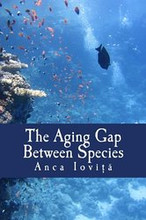 Loading... Please wait...
Loading... Please wait...Categories
The Aging Gap Between Species
Product Description
Excerpted from the CR Way blog, The Innovator Behind the Aging Gap Between Species (you must log into LivingtheCRWay.com for the link to work).
The Aging Gap Between Species is filled with fresh ideas that Anca Ioviţă got from studying differences in the ways fungi, plants, and animals age.
Dr. Ioviţă explains that aging is traditionally studied in worms, flies, and mice – species that work well in labs because of their fast rates of aging. While working with fast-aging species has value, a lot can be learned from other animals, some of which age much more slowly and effectively than humans. How can we apply this knowledge?
Hypoxic Breathing?
Well, as I write this I am already practicing something that Dr. Ioviţă’s book inspired me to learn – hypoxic breathing. I first experienced hypoxia at 27 when I lived in Toluca, Mexico, a small city that has an altitude of 8700 feet. When I first moved there, I remember being short of breath from just walking around. After a few days, my body adjusted. After living there for a year, I felt like a superhuman when I went back to New York, which is at sea level.
Anca made me aware of certain long-lived animals that live in conditions that induce hypoxia regularly. Taking a cue from alternative nostril breathing that Bhavani taught in her recent teleconference, I realized that incorporating a mild hypoxic breathing routine into my morning regimen is easy. Try it. You may find that it helps your focus for brain training and meditation.
This is just one of many ideas I’ve derived from reading The Aging Gap Between Species. Anca Ioviţă spent countless hours studying papers to write this easy-to-read book, filled with fascinating insights on how various species age and how you might apply that knowledge to your life.
How the book is organized
The chapters speak to the heart of what LivingTheCRWay members need to think about.
- Taking Life Slowly (includes Temperature and Aging)
- The Housekeeping Problem (includes buildup of Intracellular and Extracellular Junk)
- Could Reproduction Set up the Pacemaker of Senescence
- Hormones as Pacemakers of Senescence (includes Is Aging a Form of Dehydration?)
- The Immune Pacemaker of Senescence (make sure to read the case study: “Thymic Involution in Negligible Senescence Species”)
- Reverse Engineering the Body
- Down the Neoteny (the retention of juvenile features in the adult animal) Lane
- Does Aging Start when Growth Stops? (includes the Rate of Growth, Is Telomerase the New Fountain of Youth? and Telomerase Gene Therapy)
- Cancer
As Dr. Ioviţă introduces each new concept, she includes relevant case studies from species like the naked mole rat. Finding out more about mammals like the bowhead whale, which despite its huge size, lives to around 200 years old was also fascinating.
You will particularly like the chapter on hormones, which is a valuable primer on how hormones work in the aging process.
Beyond Dietary Restriction
As beneficial as dietary restriction is, we must all think beyond it if we hope to age very little as the years roll by. Listening to innovative thinkers like Anca Ioviţă is important, so you can apply their insights and benefit from them.







